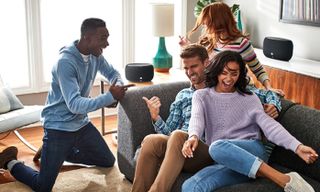JBL Link 500 Review: A Google Home Alternative with Big Sound
The JBL Link 500 is a good large speaker with Google Assistant inside, but you'll be better served with two Sonos Ones or the Google Home Max.
Why you can trust Tom's Guide

When it comes to the best smart speakers, the axiom goes: the bigger the speaker, the bigger the sound. And the bigger the price tag. JBL's $400 Link 500 joins a class of large smart speakers, such as the $399 Google Home Max, that aims to be the centerpiece of your sound system. These speakers feature more (and larger) drivers to create a fuller sound; the smart features supplied by Google Assistant serve as gravy on top. The Link 500 is definitely big, but is it worth the cost?
Design
Available in black or white, the 14.6 x 7.9 x 6.2-inch Link 500 dominates the space in which you place it. It's larger than the 13.2 x 7.4 x 6.0-inch Google Home Max and similar to the 14.3 x 8 x 6-inch Sonos Play:5. Wrapped in mesh and capped with hard plastic on top and bottom, it fits visually with other models in JBL's Link line.

Inside, the unit features two 3.5-inch woofers and two 0.8-inch tweeters — you're essentially getting two JBL Link 300 speakers in one unit. The size and shape of the unit helps spread sound widely.

JBL added two microphones on top so Google Assistant can hear your commands clearly, as well as controls for volume, play/pause, muting the microphone and pairing with other devices via Bluetooth. On the front, four LEDs blink when Google Assistant is listening; the lights also indicate the volume when you change it.

The Link 500 lacks any wired input, such as a 3.5mm auxiliary connection — something both the Google Home Max and Sonos Play:5 offer.
Google Assistant
Google Assistant was responsive to commands from across the room, and as quick to act as on a Google speaker. I checked the weather, turned on a Wemo Switch, listened to a station on TuneIn and used my voice to play YouTube videos on a Chromecast.
MORE: 32 Best Things Google Assistant Can Do
However, you can't make calls; Google says this feature will be coming to third-party speakers in the future.
Audio Performance
The Link 500 delivers full, well-balanced bass, treble and midrange tones — as long as you listen to music that's loud enough. At low volumes, the unit lacks rich bass; it doesn't really kick in until you get to about 50 percent volume, which may be louder than you want for casual listening.

Unfortunately, there's no way to adjust the bass levels, and the unit lacks automated room correction, like the Sonos One and Google Home Max offer.
When played loud enough, the Link 500 does a better job than the Link 300 at balancing throbbing bass while delivering clear vocals on songs such as The Weeknd's "Pray for Me" and Tank and the Bangas' "Smoke.Netflix.Chill." The distorted guitars on Courtney Barnett's "City Looks Pretty" had excellent detail, and the swirling mix showed off the separate left and right channels of the unit. The Link 500's crisp treble stood out when playing the acoustic guitars on Big Star's "Thirteen," while Miles Davis' horn on "Summertime" sounded sharp, though the acoustic bass — even at loud volume — was less prominent than on a Sonos Play:5.
MORE: Best Bluetooth Speakers for Home or On-the-Go
Surprisingly, the Link 500 doesn't get as loud as the Link 300. The Link 500 maxed out at 94 decibels, while the Link 300 pushes the limits of safe listening at 100 decibels. But even at 94 decibels, the Link 500 has plenty of power to fill a large room.
Wireless and Setup
To set up the speaker, you use the Google Home app. It walks you through the setup, which includes connecting to your Wi-Fi network at either 2.4 or 5 GHz. You can also connect to devices via Bluetooth, if you want to stream audio from sources Google Assistant doesn't support, such as Apple Music.
Bottom Line
With its size and stereo output, the $400 JBL Link 500 is capable of being the centerpiece to your smart speaker sound system. Google Assistant works well, and at the right volume, the Link 500 produces very good sound.
But at that price, you could also get two Link 300s — or better yet, two Sonos Ones — and have more flexibility in your speaker arrangement. If you want a single unit, the Google Home Max and the Sonos Play:5 both offer something the Link 500 doesn't: a wired input, which could be used for adding a turntable, a CD player, a TV or other audio source. The Link 500 is a good, big smart speaker, but it could be better.
Credit: JBL
Sign up to get the BEST of Tom’s Guide direct to your inbox.
Upgrade your life with a daily dose of the biggest tech news, lifestyle hacks and our curated analysis. Be the first to know about cutting-edge gadgets and the hottest deals.

Michael Gowan is a freelance technology journalist covering soundbars, TVs, and wireless speakers of all kinds of shapes and sizes for Tom’s Guide. He has written hundreds of product reviews, focusing on sound quality and value to help shoppers make informed buying decisions. Micheal has written about music and consumer technology for more than 25 years. His work has appeared in publications including CNN, Wired, Men’s Journal, PC World and Macworld. When Michael’s not reviewing speakers, he’s probably listening to one anyway.
